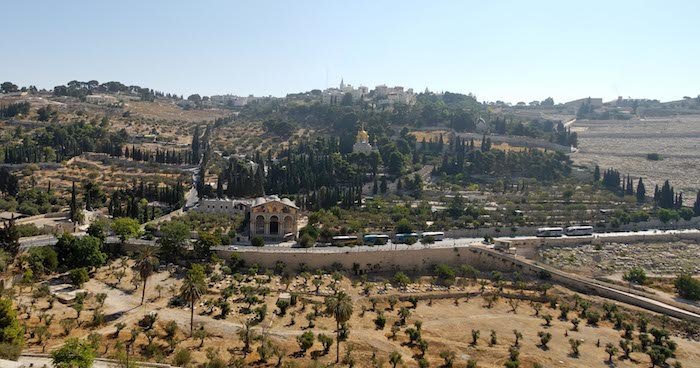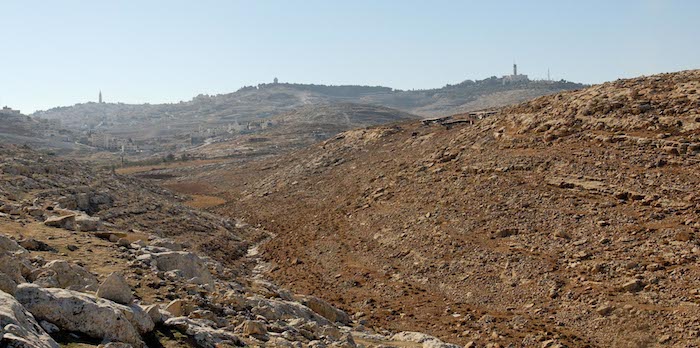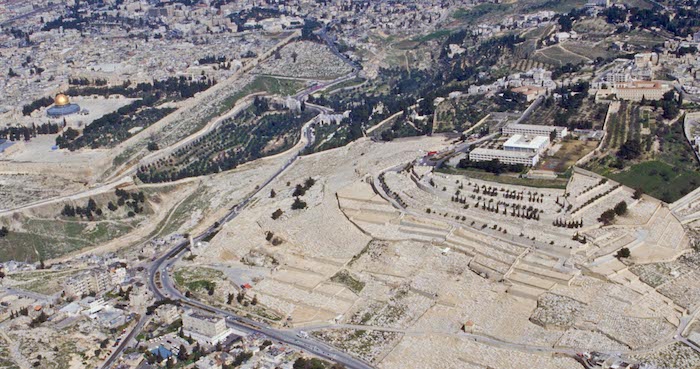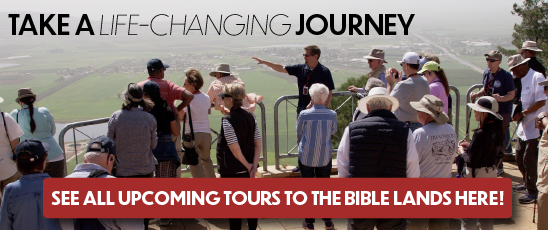How fitting that the first mention of the Mount of Olives in the Bible represents the irony that would occur on its slopes throughout the centuries.
In King David’s day, the summit of the Mount of Olives held a place “where God was worshiped” (2 Samuel 15:32). And yet, that same context revealed the rejection of God’s chosen king, David, who crossed the Kidron Valley and ascended the slope weeping as he fled from his rebellious son.

(Photo: The Mount of Olives. Courtesy of the Pictorial Library of Bible Lands)
David’s mournful exit as Jerusalem’s rejected king offers an ominous foreshadowing of the ultimate Son of David’s rejection on those same slopes a thousand years later.
But the history that occurred on Mount of Olives does more than tell the story of rejection. It speaks of redemption and — one day — of the ultimate acceptance of the King.
More than that, it tells our own story.
The Mount of Olives & Jerusalem
Always associated with Jerusalem but never part of the city, the Mount of Olives is located just east and rises 330 feet above the Old City. This watershed of the Hill Country offers beautiful views of Jerusalem to the west as well as of the Wilderness of Judea and the Jordan Valley to the east.

(Photo: The 3 towers on the Mount of Olives identify it from any distance. Courtesy of the Pictorial Library of Bible Lands)
The historian Josephus wrote that Mount Scopus, the northern-most part of the Mount of Olives, often represented “the first sight of the city” (War 5:67-70). The mount takes its name from the Greek skopus, which refers to a “watchman” or a “mark” on which one sets his or her eye. For most pilgrims ascending to Jerusalem from Jericho today, Mount Scopus still represents their first sight of Jerusalem.
Perhaps its high elevation gave rise to the worship of God on the summit prior to Solomon’s construction on the Temple Mount (2 Samuel 15:32).
Regrettably, Solomon also constructed pagan shrines on the Mount of Olives—at the “Hill of Offense”—opposite the City of David at modern Silwan (2 Kings 23:13).
Its view of Jerusalem proved beneficial to enemies. The Tenth Roman Legion camped on the Mount of Olives, opposite the Temple Mount, when they destroyed Jerusalem in AD 70. Titus camped further north with the Twelve and Fifteenth Legions on Mount Scopus.
Jesus on The Mount of Olives — The Place of God’s Coming, Going, and Coming Again
The belief that the Kidron Valley is the future Valley of Jehoshaphat (“The Lord Judges”), where God will judge humanity (Joel 3:2, 12), has inspired thousands of Jews to make their graves on the adjacent slopes. The world’s largest Jewish cemetery spreads across the Mount of Olives, and Muslim graves dot the slopes across the Kidron Valley below the Temple Mount.

(Photo: Mount of Olives aerial from southeast. Courtesy of the Pictorial Library of Bible Lands)
The Mount of Olives played a significant role during the Passion Week of Jesus, during which, several Messianic prophecies were fulfilled (and were made):
- Triumphal Entry: Jesus officially presented Himself to Israel as the Messiah (on the very day prophecy predicted) when He rode into Jerusalem on the back of a donkey (Ps. 118:22, 25-26; Dan. 9:25; Zech. 9:9, 16; Matt. 21).
- Olivet Discourse: After leaving the Second Temple for the final time and pronouncing judgment against Jerusalem, Jesus sat on the Mount of Olives with His disciples and explained prophecies that anticipated Jesus’ Second Coming (Matt. 24-25).
- Betrayal and Abandonment: On the same slope where His disciples had hailed Jesus as Messiah four days earlier, Judas betrayed Him and all of them abandoned Him (Ps. 41:9; Zech. 13:7; Matt. 26:31; John 17:12).
- Ascension: After His resurrection, Jesus gave the Great Commission to His disciples and then He ascended to heaven from the Mount of Olives (Acts 1:9-12).
- Second Coming—The place of His going will be the place of His coming. Just as Zechariah predicted the first coming of the Messiah — who appeared on the Mount of Olives — so the prophet foresaw the Second Coming of Christ whose “feet will stand on the Mount of Olives” (Zech. 14:1-4, 9).
Churches on The Mount of Olives — Where These Events are Commemorated
Many churches dot the slopes of the Mount of Olives, memorializing key events in the ministry of Jesus (and one that wasn’t).
- Church of the Pater Noster: The original church covered the cave of Eleona, which apocryphal legend linked with Jesus’ ascension. Later the cave became associated with the Olivet Discourse, and more recently, with the Lord’s Prayer, or the “Our Father” (pater noster). Today the Lord’s Prayer, written in more than 100 languages, adorns the cloister.
- Dominus Flevit Church: This simple, lovely chapel, shaped like an inverted teardrop, commemorates the site where Jesus wept over Jerusalem as He descended the Mount of Olives at His Triumphal Entry.
- Church of All Nations: Marking the traditional location where Jesus prayed in the Garden of Gethsemane, this beautiful church guards ancient olive trees and depicts various scenes of the fateful night when Jesus was betrayed and arrested.
- Russian Ascension Church: Russian nuns inhabit this church with its tall, square tower. Built toward the end of the nineteenth century, this tower afforded pilgrims who couldn’t journey down to the Jordan River a view of the waterway from afar.
- Church of Mary Magdalene: Constructed in 1888, this church is connected with a convent that houses more than two-dozen nuns. The Russian Orthodox church, with its beautiful golden onion-shaped domes, has a mosaic commemorating a legend that Mary Magdalene gave a miraculous egg to Emperor Tiberius.
- Mosque of the Ascension: The structure commemorates Jesus’ ascension on the Mount of Olives. The original 4th-century building has been renovated through the centuries—by the Crusaders and most recently by Muslims, who own the site today.
Explore the Mount of Olives in Google Maps. Just point, drag, and click!
The Mount of Olives—Your Rejection of Jesus and His Redemption of Us
Jesus cried twice on the Mount of Olives during His Passion Week:
- On Sunday, He wept at His Triumphal Entry because of those who would reject Him.
- On Thursday, He wept at the Garden of Gethsemane because He knew what redeeming sinners would cost Him.
We too, have each rejected God and walked our own way. But Christ’s gracious surrender to the Father at Gethsemane — leading to Jesus’ crucifixion and resurrection — has made it possible for our redemption.
For those of us who believe in Jesus, we will return with Him at His Second Coming when “His feet will stand on the Mount of Olives” (Zech. 14:4; Rev. 19:14).
Perhaps then—as never before—will the Mount of Olives once again be a place “where God [is] worshiped” (2 Samuel 15:32).
See the Bible Come to Life
Want to see the Mount of Olives and other biblical sites for yourself? Sign up for an upcoming tour.
Tell me what you think: Have you seen the Mount of Olives? What did you think? To leave a comment, just click here.

